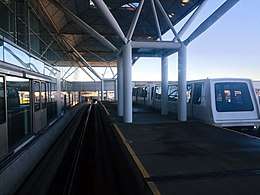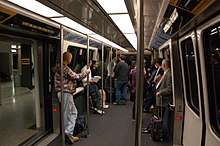Stansted Airport Transit System
The Stansted Airport Track Transit System (TTS) is a fully automated people mover system which operates within London Stansted Airport in the United Kingdom.[1]
 An Adtranz C-100 vehicle approaches the Terminal station | ||||||||||||||||||||||||||||||||||||||||
| Overview | ||||||||||||||||||||||||||||||||||||||||
|---|---|---|---|---|---|---|---|---|---|---|---|---|---|---|---|---|---|---|---|---|---|---|---|---|---|---|---|---|---|---|---|---|---|---|---|---|---|---|---|---|
| Locale | London Stansted Airport, | |||||||||||||||||||||||||||||||||||||||
| Transit type | Automated guideway transit/People mover | |||||||||||||||||||||||||||||||||||||||
| Number of lines | 1 | |||||||||||||||||||||||||||||||||||||||
| Number of stations | 3 | |||||||||||||||||||||||||||||||||||||||
| Daily ridership | 36000 | |||||||||||||||||||||||||||||||||||||||
| Annual ridership | 13 million per year | |||||||||||||||||||||||||||||||||||||||
| Website | Stansted Airport Terminal Guide | |||||||||||||||||||||||||||||||||||||||
| Operation | ||||||||||||||||||||||||||||||||||||||||
| Began operation | 1991 | |||||||||||||||||||||||||||||||||||||||
| Operator(s) | Stansted Airport Limited | |||||||||||||||||||||||||||||||||||||||
| Number of vehicles | 8 in normal operation | |||||||||||||||||||||||||||||||||||||||
| Technical | ||||||||||||||||||||||||||||||||||||||||
| System length | 2 miles (3.2 km) | |||||||||||||||||||||||||||||||||||||||
| ||||||||||||||||||||||||||||||||||||||||
The transit system conveys air passengers between the main airport terminal and the departure/arrival gates, which are located some distance from the main terminal in satellite buildings. The system operates exclusively "airside", meaning that it can only by accessed by passengers who have first passed through airport security. The transit is provided free of charge.[2][3]
History
The Stansted Airport Transit System was opened in 1991. It was constructed as a result of the decision by the British Airports Authority (BAA) to redevelop the airport with an arrangement of satellite buildings detached from the main terminal. The BAA considered several options for conveying passengers safely and rapidly to the airport gates, including moving walkways, tunnels, bridges and bus links, before opting for an automated tracked transit system. After opening in 1991 the system was extended in 1998 with an additional two underground stations, to serve a second and a third satellite building.[1]
Route
Guideway
The Stansted Airport TTS vehicles run along a double-track guideway totalling 3.2 kilometres (2.0 mi) in length[1] which connects the main terminal building with three satellite buildings. The route begins on an elevated section alongside the departure lounge, before entering a tunnel which passes beneath the airport apron.[4] There is a maintenance depot at one end.
Stations
The Transit System has three stations: Terminal, Gates 1–19 (Satellite 1) and Gates 20–39 (Satellite 2). Satellite 3 (Gates 40–59) is not served by the Transit System; instead a pedestrian footway links the gates with the main terminal.[3]
Each station has segregated boarding and alighting platforms, allowing a more efficient passenger flow. All boarding points are equipped with platform screen doors.
In the main terminal, arriving passengers have landside access to Stansted Express rail services to London and elsewhere from Stansted Airport railway station.[5][4]
Vehicles

There were originally five Adtranz C-100 cars built by Westinghouse for the system. This was increased to nine when four new Adtranz CX-100 cars were delivered during the 1998 expansion.[1] During normal operation, eight out of the nine cars will be in service to maintain a 99.98% availability record.[1][3] The cars can operate as single units or can be coupled to form two or three car trains. The trains are fully automated and driverless.
Future developments
In 2016, Stansted Airport's parent company, Manchester Airport Group, awarded a £2.1m contract to replace the Automatic Train Operation central control system of the Stansted Airport Transit System to Firstco.[6]
Construction of a fourth satellite terminal has been proposed for Stansted Airport. Although expansion plans are not currently certain, it is thought that a fourth satellite building will be served by a TTS station, requiring an extension of the Transit System.[3]
Pictures
- An Adtranz C-100 vehicle approaching the Main Terminal
.jpg) Platform doors at a Transit station
Platform doors at a Transit station- Set of points for a crossover connecting the two tracks
- A Transit vehicle in the tunnel section
 Map of the Stansted Transit System
Map of the Stansted Transit System In-car route information signage
In-car route information signage- Aerial view of the airport, with the Transit line visible in front of the main terminal
 C100 vehicle on elevated guideway section
C100 vehicle on elevated guideway section
References
- "24. BAA Stansted, Airport Transit System, TTS – The Track Transit System" (PDF). Cambridge University/BAA. Archived from the original (PDF) on 19 July 2011. Retrieved 11 July 2008.
- "In The Terminal". Stansted Airport website. The Manchester Airports Group plc. Archived from the original on 10 January 2018. Retrieved 10 January 2018.
- Simons, Graham; Bowman, Martin W. (2011). London's Airports. Casemate Publishers. pp. 135–6. ISBN 9781848843943. Retrieved 10 January 2018.
- Smiler, Simon. "Monorails, Maglevs and 'Cabin' Transports". citytransport.info. Archived from the original on 10 January 2018. Retrieved 10 January 2018.
- Blow, Christopher (2012). Transport Terminals and Modal Interchanges. Routledge. ISBN 9781136352294. Retrieved 10 January 2018.
- "Stansted Airport Track Transit System - Airport Technology". Airport Technology. 6 November 2017.
See also
| Wikimedia Commons has media related to Stansted Airport Track Transit System. |
Further reading
- Norton, Paul; Talyor, Jim; Smalley, Daniel (8 December 2017). Stansted Airport Track Transit System Controls Upgrade. Firstco – via Youtube.